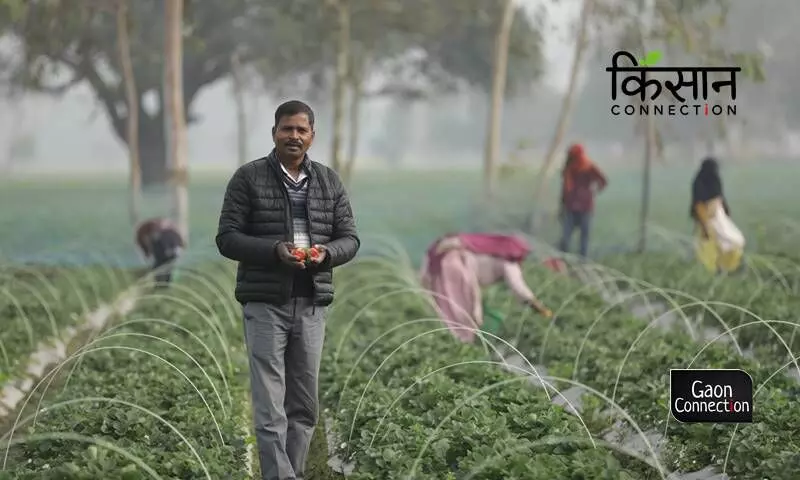Strawberries sweeten the labourer-landowner bond in Uttar Pradesh’s Barabanki
Satyendra Verma is the first farmer to take up cultivation of strawberries in Barabanki district of Uttar Pradesh and script a story of success. He not only trains other farmers in growing strawberries, a fairly new crop in the state, but also provides employment to 40 farm labourers, most of whom are women.
 Pratyaksh Srivastava 19 Jan 2023 9:36 AM GMT
Pratyaksh Srivastava 19 Jan 2023 9:36 AM GMT

Apart from the handsome earnings, Satyendra Verma also provides employment to 40 villagers who work in his orchard. Photos by Yash Sachdev
Siswara (Barabanki), Uttar Pradesh
The weak sunlight is no match for the frigid January afternoon where Shaheen Bano is trying to keep warm at a strawberry field as she tends to it. But she is not complaining.
“This is far better than standing knee-deep in water on a paddy field which is back-breaking,” the 30-year-old told Gaon Connection.
Bano, who lives two kilometres away at Durela village in Barabanki district, walks every day to the strawberry patch in the neighbouring Siswara village. The farm is owned by Satyendra Verma, a 47-year-old farmer who is the first to introduce cultivation of strawberries in the district.
It is evident that his strawberry farm is the only one there as his field is surrounded by other fields growing mustard, potatoes, and wheat. The strawberry orchard, spread over five acres [a little over an hectare], has evolved into a landmark for the rural residents in Dewa block where Siswara is.
A decade ago, in 2012, after a visit to Himachal Pradesh, Verma decided to cultivate strawberries. “It is many times more profitable than the traditional crops like paddy and wheat. I brought a thousand plants to my village and planted them despite my rudimentary understanding about the crop,” Verma told Gaon Connection.
And ever since then there has been no looking back for the strawberry farmer whose annual fruit production is 800 quintals with a profit of two million rupees per annum. Apart from the handsome earnings, Verma also provides employment to 40 villagers who work in his orchard.
Also Read: The Strawberry Farmers of Odisha
“Close to 40 labourers work in my fields for six months at a stretch. A majority of them are women. The sowing season begins around September-October and the harvest peaks in February-March,” he said. Initially, the labourers had to be provided basic training on strawberry cultivation, but according to him, they learnt quickly and are now eager to work here. “It’s a regular source of income for them for six months running,” Verma said.
The strawberry orchard, spread over five acres [a little over an hectare], has evolved into a landmark for the rural residents in Dewa block where Siswara is.
Suman Devi is one such farm labourer and working on the strawberry fields offers her benefits like none other, she said. “In other crops like mustard, paddy and wheat, labourers like me cannot earn for six consecutive months like we do here,” she told Gaon Connection.
According to her, the labourers also get weekly offs and are paid Rs 6,000 each a month. “We are also allowed to take leave in case of medical emergencies,” the 32-year-old farm labourer said.
Suman’s fellow-labourer Mohini pointed out that while the labour needed in strawberry orchards was specialised, it was not as tiring as working with staple crops.
“There are leeches that attach themselves to our legs and feet when we are knee-deep in water in the paddy fields. They suck our blood and we don’t even realise it till afterwards. This work is respectable and payments are timely too,” Mohini said.
Learning by doing
Verma explained that although a labour intensive and a capital intensive crop, strawberry cultivation is highly profitable if done in adherence to the technicalities of its cultivation.
“The thousand plants I got from Himachal in 2012, I planted those on a bigha [1/8th of an hectare] of land in 2012-2013 and invested Rs 7,000 on the cultivation. Luckily, the fruits grew well and I could recover the input cost by selling the produce in Lucknow,” he added.
Today, he cultivates strawberries on five acres of land and reaps profits amounting to almost Rs 20 lakhs per annum. But, it has been a journey of learning by doing for Verma.
“It was much later, in 2015, that I learned about the sowing techniques, insecticides, fertilisers, drip irrigation and the varieties of strawberries which helped me raise my profits, " he added.
Also Read: A farmer grows water chestnut on land stripped of soil; earns profit, repays loans
It was Verma’s visit to Bilar village in Maharashtra’s Mahabaleshwar in 2015 when he learned about the use of plastic sheets, matted row systems, drip irrigation and insecticide management to grow strawberries.
“After I incorporated these techniques, my fortunes grew. In my childhood, we just had a small land holding which only produced enough grains to fill our stomach. Today, after almost 10 years of cultivating and experimenting with strawberries, I own a house, two cars, and my children could go to private schools in Lucknow. It would have been impossible had I been stuck with the staple crops,” Verma said.
Strawberry is an exotic fruit and even the local government support is minimal for such crops.
According to him, when he started growing strawberries, nobody in the area had even seen this fruit before. “It was difficult to sell it in large quantities initially. We convinced fruit juice shops in Lucknow to include strawberry juice in their menu. I also convinced some of them to make strawberry pulp concentrates for making milkshakes. All that required a lot of convincing and legwork. We literally were the pioneers in supplying strawberries,” Verma said with a sense of pride.
Also Read: UP: Unnao's first women-led SHG for Thai guava cultivation promises better incomes for farmers
Training other farmers
“Whenever farmers from the nearby villages approach me for guidance to cultivate strawberries, I tell them to start by experimenting with a small land holding. There are farmers who have lost a fortune by being over ambitious and neglecting the learning aspect of cultivation,” Verma said.
“Strawberry is an exotic fruit and even the local government support is minimal for such crops. I had to travel to states like Himachal Pradesh, Haryana, and Maharashtra to understand strawberry cultivation by observing farmers there,” he said.
“Such crops need a lot of information about cultivation techniques and about markets. Many farmers watch videos on YouTube and invest huge money on a large scale despite having no experience. Experience is crucial but always start small,” Verma warned.
Source: National Horticulture Board
Meanwhile, the district horticulture officer in Barabanki told Gaon Connection that the department provides financial assistance of Rs 50,000 per hectare of land for cultivation of strawberries.
“It is a cash crop and requires significant investment. However, the government wants farmers to get high profits on their produce which is not possible in staple food crops. In the entire district, the strawberry is cultivated on about 40 acres [16.9] hectares of land,” Mahesh Kumar Srivastava, the district horticulture officer told Gaon Connection.
However, Satyendra Verma, the farmer said that an assistance of Rs 50,000 per hectare is not much when it comes to the total input cost.
“We refrain from availing this benefit. Not only is the amount too less in terms of input cost, the time lost in the formalities and paperwork of getting the amount is not worth it. Also, the payments are hardly on time,” Verma said.
Meanwhile, Shaheen Bano said she liked the taste of strawberries, but would prefer not to eat it right away. “I like the taste but it’s very cold right now and abhi khaane se gala kharaab ho jaayega [eating it now will give me a sore throat,” she smiled.
Strawberry Strawberry Cultivation Farmers Kisaan Connection Uttar Pradesh
More Stories




